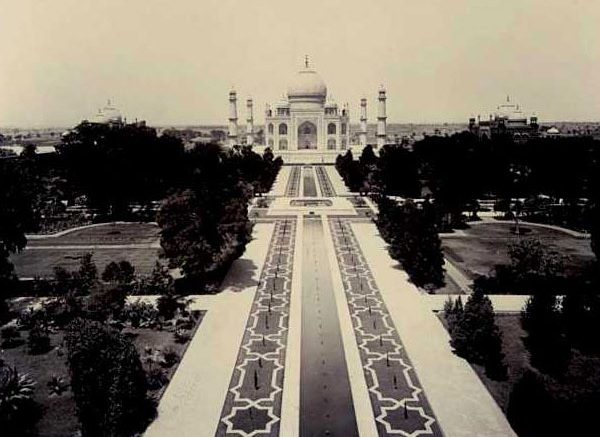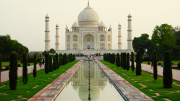On Thursday the Central Information Commission asked the Government whether the Taj Mahal was a mausoleum or a Shiva temple. The directive was issued on an RTI application which sought the information. This issue has been debated for long a petition a few years back in the Supreme Court too had been struck down after it was said that the Taj Mahal was originally a vedic temple. P N Oak had written a book, Taj Mahal a true story in which he argues that it was a hindu temple. Let us understand what the entire issue is about and why many have said that the Taj Mahal in reality is Tejo Mahalay. Several sites have posted arguments on why the Taj Mahal was in reality a temple and not the tomb of Mumtaz, wife of Mughal ruler Shahjahan.
Taj Mahal or Tejo Mahalay The term Tajmahal itself never occurs in any mogul court paper or chronicle even in Aurangzeb’s time. “Mahal”is never muslim because in none of the muslim countries around the world from Afghanistan to Algeria is there a building known as “Mahal”. The explanation of the term Tajmahal derives from Mumtaz Mahal, who is buried in it, is illogical- Her name was never Mumtaj Mahal but Mumtaz-ul-Zamani. Several European visitors of Shahjahan’s time allude to the building as Taj-e-Mahal is almost the correct tradition, age old Sanskrit name Tej-o-Mahalaya, signifying a Shiva temple. The term Taj Mahal is a corrupt form of the sanskrit term TejoMahalay signifying a Shiva Temple. Agreshwar Mahadev i.e., The Lord of Agra was consecrated in it. The tradition of removing the shoes before climbing the marble platform originates from pre Shahjahan times when the Taj was a Shiva Temple. Had the Taj originated as a tomb, shoes need not have to be removed because shoes are a necessity in a cemetery.
Visitors may notice that the base slab of the centotaph is the marble basement in plain white while its superstructure and the other three centotaphs on the two floors are covered with inlaid creeper designs. This indicates that the marble pedestal of the Shiva idol is still in place and Mumtaz’s centotaphs are fake. In India there are 12 Jyotirlingas i.e., the outstanding Shiva Temples. The Tejomahalaya alias The Tajmahal appears to be one of them known as Nagnatheshwar since its parapet is girdled with Naga, i.e., Cobra figures. The famous Hindu treatise on architecture titled Vishwakarma Vastushastra mentions the ‘Tej-Linga’ amongst the Shivalingas i.e., the stone emblems of Lord Shiva, the Hindu deity. Such a Tej Linga was consecrated in the Taj Mahal, hence the term Taj Mahal alias Tejo Mahalaya.
Agra city, in which the Taj Mahal is located, is an ancient centre of Shiva worship. Its orthodox residents have through ages continued the tradition of worshipping at five Shiva shrines before taking the last meal every night especially during the month of Shravan.
Documents Shahjahan’s own court chronicle, the Badshahnama, admits (page 403, vol 1) that a grand mansion of unique splendor, capped with a dome (Imaarat-a-Alishan wa Gumbaze) was taken from the Jaipur Maharaja Jaisigh for Mumtaz’s burial, and the building was known as Raja Mansingh’s palace. The plaque put the archealogy department outside the Taj Mahal describes the edifice as a mausoleum built by Shahjahan for his wife Mumtaz Mahal , over 22 years from 1631 to 1653. That plaque is a specimen of historical bungling. Firstly, the plaque sites no authority for its claim. Secondly the lady’s name was Mumtaz-ulZamani and not Mumtazmahal. Thirdly, the period of 22 years is taken from some mumbo jumbo noting by an unreliable French visitor Tavernier, to the exclusion of all muslim versions, which is an absurdity.
Prince Aurangzeb’s letter to his father,emperor Shahjahan,is recorded in atleast three chronicles titled `Aadaab-e-Alamgiri’, `Yadgarnama’, and the `Muruqqa-i-Akbarabadi’ (edited by Said Ahmed, Agra, 1931, page 43, footnote 2). In that letter Aurangzeb records in 1652 A.D itself that the several buildings in the fancied burial place of Mumtaz were seven storeyed and were so old that they were all leaking, while the dome had developed a crack on the northern side. Aurangzeb, therefore, ordered immediate repairs to the buildings at his own expense while recommending to the emperor that more elaborate repairs be carried out later. This is the proof that during Shahjahan’s reign itself that the Taj complex was so old as to need immediate repairs. The ex-Maharaja of Jaipur retains in his secret personal `KapadDwara’ collection two orders from Shahjahan dated Dec 18, 1633 (bearing modern nos. R.176 and 177) requestioning the Taj building complex. That was so blatant a usurpation that the then ruler of Jaipur was ashamed to make the document public.
The Rajasthan State archives at Bikaner preserve three other firmans addressed by Shahjahan to the Jaipur’s ruler Jaising ordering the latter to supply marble (for Mumtaz’s grave and koranic grafts) from his Makranna quarris, and stone cutters. Jaisingh was apparently so enraged at the blatant seizure of the Tajmahal that he refused to oblige Shahjahan by providing marble for grafting koranic engravings and fake centotaphs for further desecration of the Tajmahal. Jaising looked at Shahjahan’s demand for marble and stone cutters, as an insult added to injury. Therefore, he refused to send any marble and instead detained the stone cutters in his protective custody. The three firmans demanding marble were sent to Jaisingh within about two years of Mumtaz’s death. Had Shahjahan really built the Tajmahal over a period of 22 years, the marble would have needed only after 15 or 20 years not immediately after Mumtaz’s death.
Moreover, the three mention neither the Tajmahal, nor Mumtaz, nor the burial. The cost and the quantity of the stone also are not mentioned. This proves that an insignificant quantity of marble was needed just for some supercial tinkering and tampering with the Tajmahal. Even otherwise Shahjahan could never hope to build a fabulous Tajmahal by abject dependence for marble on a non cooperative Jaisingh.
Research :
Well known Western authorities on architechture like E.B.Havell, Mrs.Kenoyer and Sir W W Hunterhave have gone on record to say that the Taj Mahal is built in the Hindu temple style. Havell points out the ground plan of the ancient Hindu Chandi Seva Temple in Java is identical with that of the Taj. A central dome with cupolas at its four corners is a universal feature of Hindu temples. The four marble pillars at the plinth corners are of the Hindu style. They are used as lamp towers during night and watch towers during the day. Such towers serve to demarcate the holy precincts. Hindu wedding altars and the altar set up for God Satyanarayan worship have pillars raised at the four corners. The octagonal shape of the Tajmahal has a special Hindu significance because Hindus alone have special names for the eight directions, and celestial guards assigned to them. The pinnacle points to the heaven while the foundation signifies to the nether world. Hindu forts, cities, palaces and temples genrally have an octagonal layout or some octagonal features so that together with the pinnacle and the foundation they cover all the ten directions in which the king or God holds sway, according to Hindu belief. The Taj Mahal has a trident pinncle over the dome. A full scale of the trident pinnacle is inlaid in the red stone courtyard to the east of the Taj. The central shaft of the trident depicts a “Kalash” (sacred pot) holding two bent mango leaves and a coconut. This is a sacred Hindu motif. Identical pinnacles have been seen over Hindu and Buddhist temples in the Himalayan region. Tridents are also depicted against a red lotus background at the apex of the stately marble arched entrances on all four sides of the Taj. People fondly but mistakenly believed all these centuries that the Taj pinnacle depicts a Islamic cresent and star was a lighting conductor installed by the British rulers in India. Contrarily, the pinnacle is a marvel of Hindu metallurgy since the pinnacle made of non rusting alloy, is also perhaps a lightning deflector. That the pinnacle of the replica is drawn in the eastern courtyard is significant because the east is of special importance to the Hindus, as the direction in which the sun rises. The pinnacle on the dome has the word `Allah’ on it after capture. The pinnacle figure on the ground does not have the word Allah.
Cost :
The cost of the Taj is nowhere recorded in Shahjahan’s court papers because Shahjahan never built the Tajmahal. That is why wild estimates of the cost by gullible writers have ranged from 4 million to 91.7 million rupees. Likewise the period of construction has been guessed to be anywhere between 10 years and 22 years. There would have not been any scope for guesswork had the building construction been on record in the court papers. The designer of the Tajmahal is also variously mentioned as Essa Effendy, a Persian or Turk, or Ahmed Mehendis or a Frenchman, Austin deBordeaux, or Geronimo Veroneo, an Italian, or Shahjahan himsellf.


Be the first to comment on "Taj Mahal or Tejo Mahalay: What is the real story"